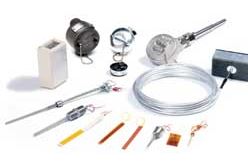 RTD, thermocouple or thermistor: Which temperature sensor is right for you?
RTD, thermocouple or thermistor: Which temperature sensor is right for you?
December 17, 2014 REDWIRE is news you can use from leading suppliers. Powered by FRASERS.
Posted by Mod-Tronic Instruments Ltd.
We are a representative/distributor of twelve leading manufacturers of industrial/commercial Sensors, Transducers, Heate... Read more
Subscribe
Free REDWIRE e-newsletter

Are you trying to decide which temperature sensor is the right fit for your application? This article takes a look at the advantages of resistance temperature detectors (RTD), thermocouples and thermistors, to help you determine the best solution for your needs.
Resistance temperature detectors: An RTD sensing element consists of a wire coil or deposited film of pure metal. The element’s resistance increases with temperature in a known and repeatable manner. RTDs exhibit excellent accuracy over a wide temperature range, and represent the fastest growing segment among industrial temperature sensors. Their advantages include: a temperature range from -260 to 850 degrees C; repeatability and stability; sensitivity (the voltage drop across an RTD provides a much larger output than a thermocouple); linearity (platinum and copper RTDs produce a more linear response than thermocouples or thermistors); low system cost; and standardization (manufacturers offer RTDs to industry standard curves).
Thermocouples: A thermocouple consists of two wires of dissimilar metals welded together into a junction. Though thermocouples are simple and familiar, designing them into systems is complicated by the need for special extension wires and reference junction compensation. Their advantages include: extremely high temperature capability (rated as high as 1,800 degrees C); resistance to shock and vibration; and small size and fast response.
Thermistors: A thermistor is a resistive device composed of metal oxides formed into a bead and encapsulated in epoxy or glass. A typical thermistor shows a large negative temperature coefficient. Resistance drops dramatically and non-linearly with temperature. Sensitivity is many times that of RTDs, but useful temperature range is limited. Their advantages include: low sensor cost (basic thermistors are quite inexpensive, but models with tighter interchangeability or extended temperature ranges often cost more than RTDs); high sensitivity (can change resistance by tens of ohms per degree temperature change, versus a fraction of an ohm for RTDs); and a thermistor bead can be made the size of a pin head for small area sensing.
For more information, contact Mod-Tronic, the Brampton, Ont.-based distributor of MINCO temperature sensors.
Share
Posted by Mod-Tronic Instruments Ltd.
We are a representative/distributor of twelve leading manufacturers of industrial/commercial Sensors, Transducers, Heate... Read more
